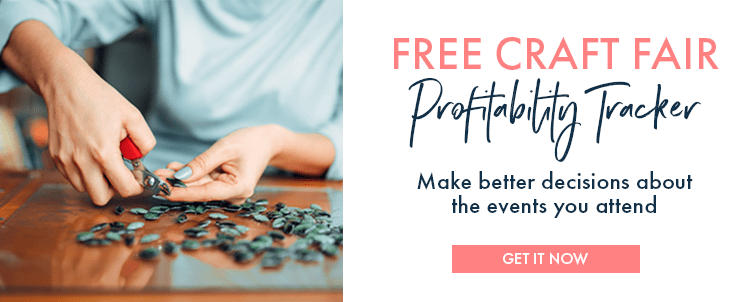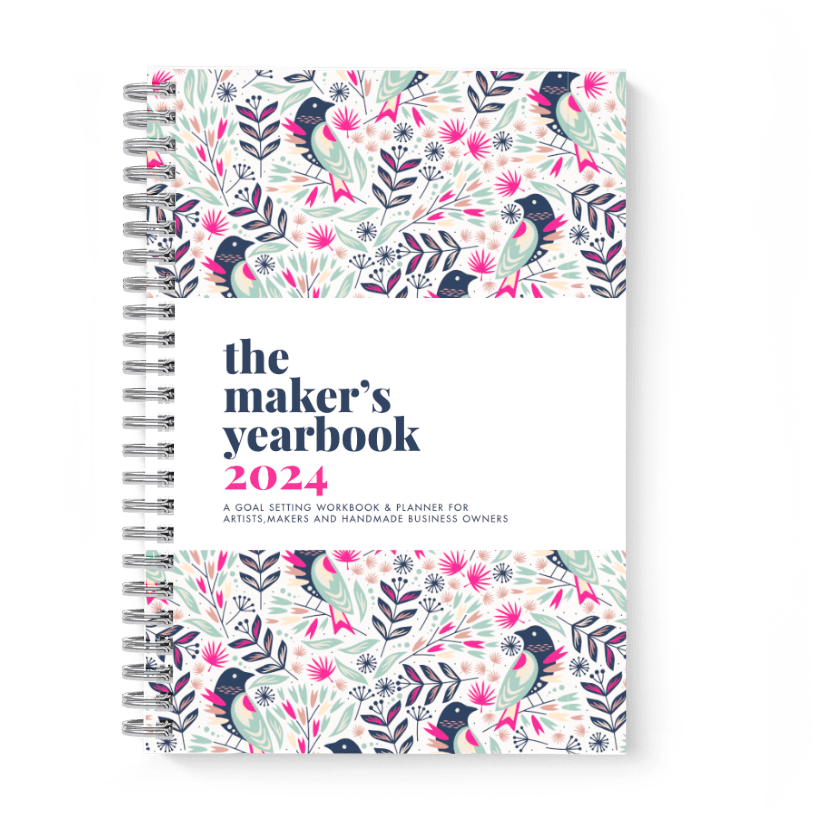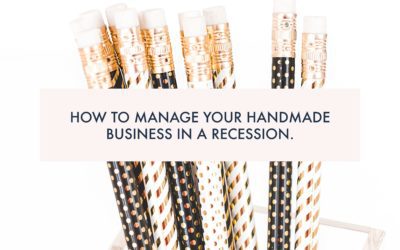Massive Disclaimer Alert!!!
A show that is great for one person might be rubbish for another. And a show that is rubbish for one person might be great for someone else. Picking craft fairs is all about picking the craft fair that is right FOR YOU.
This article is just about spotting fairs that may receive very low attendance or very low average spend and therefore will be bad for everyone. You might still do well at events that have some of these “red flags.” You might do very well. But they are a gamble and you should treat them as such.
The two types of craft fair
The standard wisdom on how to research a craft fair says that you should contact the organisers and ask them questions about the footfall or the kind of advertising they do. You might also ask other artists and crafters who have taken part before what they think of the event.
But, before you do any of that, you need to be clear about the type of event this is, because there are two different types of craft fair (and a few special situations we’ll talk about at the end.) These two types of fair are quite different from each other, are likely to attract very different customers, need a different kind of promotion and also need a different approach from you.
You need to be clear about which one you are applying for so that you can research and plan accordingly.
The two main types of events are passing trade events and destination events.
Let’s look at the difference between the two.
Passing Trade Events
Passing Trade Events, as the name suggests, mostly rely on people who are already passing the venue, seeing that an event is taking place and coming in to take a look.
These customers have not made a special trip to visit the event. They were doing something else, they saw the event, and they decided to stop in.
This is important because it is important to remember that only a certain proportion of people who pass by an event will decide to come in. Perhaps they have no interest in buying handmade. Perhaps they haven’t got any money with them. Perhaps they are rushing to meet a friend, thought the event looked interesting but they were late and they didn’t come in.
Passing trade events don’t just have to be in town centres.
They can be at stately homes, agricultural shows, winter wonderland events etc. Essentially, any event where visitors come to the event for a reason other than to shop. I’d even include Art Festivals where visitors come primarily for demonstrations in this category.
Destination Events
Destination Events are events where the customers, for the most part, make a special trip to come to the event. Perhaps it is a show held once or twice a year and the customers have decided to come and have a look because there are always lovely things and maybe they can get their Christmas shopping started.
They have come with the specific intention of buying and they may have a specific budget that they are willing to spend at the show. Perhaps they’ll look around the whole show before deciding where to spend that amount that they have budgeted.
You might automatically assume that, because the customers have mostly attended the event specifically to shop, that destination events are automatically a better type of event to sell at but that’s not necessarily the case. Both types can work well, if they are organised well and they are a good fit for your particular products.
For example, passing trade events are great for impulse purchases, but tougher when it comes to selling larger pieces (people don’t want to carry them around) so they can work really well near Christmas time or on Bank Holiday weekends if they are located in busy town centres.
Destination events are great for building a following and possibly selling larger pieces that customers may have been considering since the last time you did the event.
So, in order to determine if the event is likely to be a success you have to first think about whether it is a Passing Traffic Event or a Destination Event and then assess it against the kinds of things that might make that type of event popular.
Here are some examples.
Passing trade events generally shouldn’t be in small villages or town halls where there aren’t many people passing by. They generally shouldn’t charge an entry fee because they are relying on people to just “pop in.”
A track record isn’t so important for these events because people are passing, so they don’t need to be familiar with the event, although it can be important that the passers by know that it is a handmade event, especially if it is using market stalls.
There should be as few barriers between where the public is passing and the craft fair stands – so it shouldn’t be down a side street or in the very back of a building that is otherwise pretty empty. You are most likely to sell impulse purchases rather than large pieces at a passing trade event, so consider whether the stand fee is at a level where you can still make a profit selling smaller pieces.
Destination events should have very strong and effective marketing campaigns because they need to get people to make the effort to come along.
This marketing becomes more effective the more times the event has been held so you might consider whether the destination event you are applying to is well established or relatively new.
They should have a good website with lots of information for visitors, including a clear date and time, directions and any entry fee. They should also have a mailing list for their visitors to join (preferably email rather than snail mail) and be active on social media.
Once you have applied for and been accepted to an event, it’s also a good idea to plan your stand and your offering appropriately for a passing trade or a destination event.
Planning for Passing Trade Events
You are more likely to sell smaller pieces at passing trade events. These customers are probably brand new to you. They may really love your work but not yet be ready to buy. They may have been going to meet a friend for lunch or taking their kids out for the day so they may not want to buy something they need to carry around with them.
The key with these customers is either selling them something small (so they become a buyer of your work) or developing the relationship for later. They best way to do this is to get them onto your email list where you can send them some more information about your products. Postcards and Flyers are good too but email is always best – after all how many business cards have you found in the bottom of your bag that you picked up somewhere and never looked at again?
You can even position your email list as a convenience for them with a sign that says “No time to look today? Enter your email below and let us send you our online catalogue for you to browse at your convenience”
If you are selling at a passing trade event far from where you live and you won’t be doing the event regularly, it is especially important to gather email addresses so that you can expand your audience in these areas.
You won’t be there regularly so you need another way for these customers to see your work again.
The best products to sell at a passing trade event are your best selling items at the mid to low end of your price range and items that are not too large physically.
You will also want to consider how you are going to attract attention with your display. Passing trade customers are often busy and distracted and they don’t make an effort to visit every stand so large banners with images of your products can work really well. Colour is great for grabbing attention too.
Planning for Destination Events
Destination events are great for deepening relationships with existing customers.
If you have been at the show previously and collected email addresses, make sure you contact these customers to say you will be at the show again with new pieces. You can also offer them some kind of exclusive discount or other special offer. Maybe you have free entry tickets to the show that you can offer to them.
Most mailing list providers will let you select the subscribers located within a certain distance of a particular town so, even if you don’t have a record of who came to the show last time, you can still target local people and avoid upsetting the rest of your list.
Remember, at destination events, customers will often come with a set amount of money and then decide which sellers to spend it with, so you will be competing for attention with everyone else there.
An attractive, appealing display that encourages people to pick things up will definitely help. Think about the direction from which most people will approach and put your most attention grabbing pieces in the eye line for customers approaching from that direction. You’ll also want to focus on new pieces because these are people who have probably seen your work before.
This is also a good time to show off your biggest and most expensive pieces as these are always easier to sell to existing customers who already know and like your work. You may not sell them on the day but it’s always good for these customers to know that they are available.
Other Events
There are some events that contain elements of both passing trade and destination events. The most common of these might be Open Houses or Arts Trails.
They have an element of entertainment or a “day out” but people are generally open to purchasing and many customers will come with the express purpose of purchasing artwork for a newly decorated room or new home.
As there is a range of customers, you’ll want to have a range of product price levels available for them and, of course, you’ll want to collect as many email addresses as possible.
And, of course, all of this is just a framework to help you decide if you think a particular art or craft fair is a good use of your time and money. Don’t forget that your time is just as precious as your money. If you could spend a weekend creating a new product line that would sell really well in all your stockists, at shows and online or you could spend that weekend breaking even at a show, which would you choose?
The truth is that you can’t really know how things are going to go at an event. Bad weather, good weather, other events happening on the same date, school holidays, lots of events at the same venue. All of these can be bad for an event…..or sometimes good for it.
Some events break all of these rules and still work really well. I have been doing a passing trade event for the past few years that raises every passing trade event red flag. It’s in a building out of the centre of town. The building is like a maze and the event is upstairs. It has an entry fee. It has some extremely cheap goods which would normally worry me but I have sold my larger framed pieces there almost every time I have exhibited. It really shouldn’t work, but it does.
Use your judgment and your common sense. Maybe take a gamble on one or two shows a year that you’re not sure about. Maybe have a strict ceiling for what you’ll pay for stand fees and don’t pay a stand fee that you couldn’t afford to lose. Remember that your time and money are valuable and although showing your work in person to customers is one of the most powerful ways to build a relationship, you can’t build a relationship with customers who aren’t there or who aren’t interested in your work.









